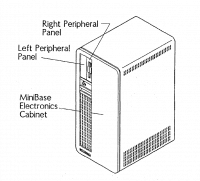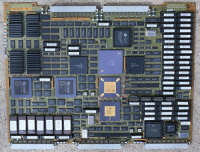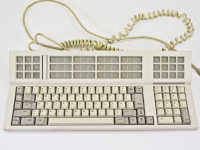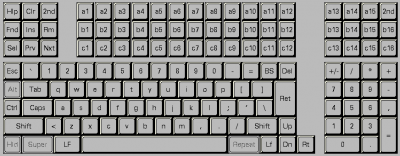Driver:InterPro: Difference between revisions
Pmackinlay (talk | contribs) (→Cards) |
Pmackinlay (talk | contribs) (→Cards) |
||
| Line 78: | Line 78: | ||
=== Cards === | === Cards === | ||
[[File:smt094.jpg|200px|right|thumb|EDGE-2 Plus | [[File:smt094.jpg|200px|right|thumb|SMT094, an EDGE-2 Plus graphics card]] | ||
A range of approximately 150 installable cards were produced for the InterPro family. The most common and important of these included the system mainboards and several different graphics options, however a range of less common cards supported functions such as video capture, SCSI expansion, networking and a VME bridge were available. Desktop InterPro systems support the installation of two cards in addition to the main board, using an interface referred to as CBUS. Larger systems supported either 5 or 12 slots with an interface referred to as SRX, which is physically incompatible with CBUS. | A range of approximately 150 installable cards were produced for the InterPro family. The most common and important of these included the system mainboards and several different graphics options, however a range of less common cards supported functions such as video capture, SCSI expansion, networking and a VME bridge were available. Desktop InterPro systems support the installation of two cards in addition to the main board, using an interface referred to as CBUS. Larger systems supported either 5 or 12 slots with an interface referred to as SRX, which is physically incompatible with CBUS. | ||
Regardless of type, | Regardless of type, card names are typically prefixed by the letter M, followed by PCB or SMT (the latter designation indicating a surface-mount board), followed by a 3-digit board type. Boards are also typically marked with a single alphabetic revision number and an ECO (engineering change order) level recording hardware-level fixes. | ||
Examples include MPCB963, which is described as "2000 Graphics f/1 1Mp Monitor", and MSMT094, which is an "EDGE-2 Plus Processor f/1 2Mp-FB". | Examples include MPCB963, which is described as "2000 Graphics f/1 1Mp Monitor", and MSMT094, which is an "EDGE-2 Plus Processor f/1 2Mp-FB". | ||
Revision as of 11:44, 17 July 2018
Intergraph InterPro
The Intergraph InterPro brand name refers to a range of computers featuring the CLIPPER processor, and running CLIX, a port of UNIX System V release 3.1.
Status
The MAME driver for the InterPro is a work in progress, and is currently capable of booting and running the CLIX operating system and some software for the InterPro 2020 configuration. Some other models are capable of booting the diagnostic monitor and disk-based diagnostic utilities, but not yet able to install or run CLIX.
Hardware
Models
The InterPro range consists of 5 distinct generations or families, named after gemstones. The system models within each family share a common architecture and features, usually differing only by CPU type and clock speed.
| Year | Family | Models | CPU | I/O Processor |
|---|---|---|---|---|
| 1986 | Amethyst | 32C/100/200 300 |
C100 | 80186 80386 |
| 1988 | Topaz | 3000/4000/5000 | C300/C300Plus | 80386 |
| 1990 | Emerald | 6000/6100/6200/6500 6600 |
C300/C300Plus C4 | |
| 1990 | Turquoise | 2000 | C300 | |
| 1992 | Sapphire | 2400/6400 2500/2700/2800/6700/6800 |
C4T C4I |
For Emerald, Turquoise and Sapphire systems, the four-digit model number encodes some aspects of the original system configuration, and breaks down as follows.
| Position | Purpose | Values |
|---|---|---|
| 1 | Case | 2=desktop, 6=minicase |
| 2 | CPU | 0=C300, 4=C4T, 6=C4, 5/7/8=C4I |
| 3 | Graphics | 0=none, 3=MMG, 5=GTDB, 4=EDGE-1, 8=EDGE-2 |
| 4 | Backplane | 0=standard, 5/7/9=? |

As examples using this encoding, an InterPro 2020 is a desktop C300 system fitted with MMG graphics, while an InterPro 6880 is a minicase C4I system with EDGE-2 graphics. Systems configured without graphics are typically fitted with a serial terminal, and branded InterServe rather than InterPro. This model numbering and branding applies to the system cases, but of course changing graphics options will cause a system's software-identified model number to change.
Cards

A range of approximately 150 installable cards were produced for the InterPro family. The most common and important of these included the system mainboards and several different graphics options, however a range of less common cards supported functions such as video capture, SCSI expansion, networking and a VME bridge were available. Desktop InterPro systems support the installation of two cards in addition to the main board, using an interface referred to as CBUS. Larger systems supported either 5 or 12 slots with an interface referred to as SRX, which is physically incompatible with CBUS.
Regardless of type, card names are typically prefixed by the letter M, followed by PCB or SMT (the latter designation indicating a surface-mount board), followed by a 3-digit board type. Boards are also typically marked with a single alphabetic revision number and an ECO (engineering change order) level recording hardware-level fixes.
Examples include MPCB963, which is described as "2000 Graphics f/1 1Mp Monitor", and MSMT094, which is an "EDGE-2 Plus Processor f/1 2Mp-FB".
Keyboard


Configuration
Machine configuration